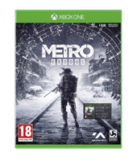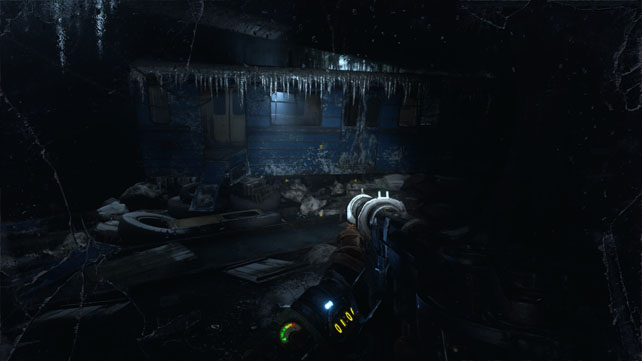There have been two games prior to the latest release in the Metro series, both of which followed ranger Artyom’s life in the Moscow underground 20 years after nuclear war has afflicted the planet. Existing in the dark, scavenging to live, and dealing with the mutated creatures and warped humans, all the inhabitants believed that there was nothing on the ravaged surface… but that turned out not to be true. Metro: Exodus continues the adventure beyond the confines of the tunnels under the city, treating us to a fascinating yet brutal interpretation of post apocalyptic Russia.
It’s fair to say that whilst the first two games in the series received critical acclaim, they weren’t quite the commercial successes that maybe they deserved. Over the 6 years since Last Light, both have received current generation remasters to introduce those that might have missed them first time around to the Dmitry Glukhovsky created world; and give gamers the chance to re-familiarise themselves with what’s happened before getting thrown in the rollercoaster ride that Metro: Exodus promises. The main challenge would always be in whether the expertise the developer has in creating interesting yet linear levels could be transferred to the ambition of semi-open world design. Getting the players out of the Moscow tunnels is a matter of abridging the longer events of the Metro 2035 novel and mixing the gameplay with what 4A do best. Keeping them engaged out in the countryside is a much tougher prospect, and it’s one that it seems came naturally to the development team.
Starting out in the prologue, the setup is pure Metro – a single guided route, a beautifully devastated world with a drip feed of environmental storytelling, and monsters trying to tear the gas mask from your face. It’s a great introduction to what survival in Moscow is all about, and it doesn’t hurt that the details are top notch. It’s the little touches that cement the reality like the fogging of the bottom of your visor with each breath; the weight and heft of the Shambler shotgun as you try to bring it to bear on a charging Watchman; and the way your flashlight doesn’t quite reach all the corners that you need it to, bringing a heightened sense of claustrophobia at each turn. There’s a palpable sense of peril and urgency as Artyom fights his way to the mysterious train, the Aurora, he’s seen hurtling through the city. Then the game changes, not just in tone but in look and feel too.
Metro: Exodus quickly establishes itself as different from the standard open world pack not least because it’s not a full open world, but because the focus is not actually on the action. It’s all about the companions escaping with you, their sense of purpose, and the story and interactions with them are paramount to getting the most out of the game. Each individual has a backstory and motivation for what they’re doing, and will happily spend time talking to Artyom in the downtime between objectives. Whether you’re out in the field with a partner or just relaxing on the Aurora, there’s usually someone to bend your ear when you pass with proximity. These interludes are optional, it’s possible to just walk on by or exit the conversation, but you’ll be missing some of the more intricate details of the crew and it lessens the bond you have with them as the mission to find a safe haven starts to get longer and longer.
Constantly driving the crew forward is the need to find somewhere to settle, and this is the hook in Metro: Exodus – where is it going to take you next? It’s not only the locations that build the intrigue, it’s the changing seasons as well. The Aurora covers thousands of kilometres on its search, and this takes in the changing weather through the year. It’s winter when you leave Moscow and encounter cultists on the banks of the river Volga. Snow, rain and lightning storms rage delivering a bleak and depressing locale. Spring sees the group heading to the source of a radio communication and the brightness and colour of the world changes the mood of the travellers. Summer and autumn follow and bring their own benefits and drawbacks, and each season is tied in brilliantly with whatever task is at hand. Droughts and parched lands mean hunting for water is essential for keeping everyone alive, as well as keeping the boilers going on the train. Lush forests offer up a potential home, but animals and humans will already been drawn to it and won’t give it up without a fight. Other cities are abandoned or irradiated and won’t be habitable, but at least the danger should mainly be from the fallout… mainly.
The wildlife on display all fit in their environments and carry across areas where logical too, and each has a particular method that works best for taking them down. Wolves, bears and spiders are the most familiar, even if they are mutated and deadly, but the ones that instil the fear are the likes of the demons, watchmen and schrimps. They are big, tough and intent on eating Artyom alive whenever they’re in range. Of course, the most difficult to deal with are usually humans – whether they’re bandits, cultists, cannibals, slavers, or irradiated mutants. Fortunately the options to deal with them are fairly broad and the use of the dark and stealth is typically the best way to tackle them rather than going head on. If you can remain undetected then there’s the option of non-lethal takedowns which goes down well with whoever you’ve done it to (obviously), but also with your comrades. There’s even a suggestion that being overly aggressive will change the story outcomes in each of the semi-open levels given the dialogue at certain points. Trying to be merciful is easier said than done though with most enemies opening fire at the merest sight of an unknown face.
This doesn’t mean that there aren’t pockets of humanity in the fractured world of Metro: Exodus. There are occasions were holstering your weapon and attempting to approach as a traveller is a perfectly viable tactic. If they start talking to you then it’s all good… if they start shooting then you better get to cover and be ready to fight back. A lovely touch to this is that if you manage to overthrow enough of the opposing force, the remaining members might get cold feet and decide that surrendering is the best option making the mop up and collecting the spoils easy; and the looting is essential. Crafting pays a significant part as it’s very rare to find exactly what you need lying around. Health packs and gas mask filters alongside certain types of ammo can be put together out in the field just by slipping off your backpack, though more complex items need a workbench. Equipment needs to be maintained too like patching broken face-plates, and failing to look after your guns will cause them to jam and overheat in addition to being less effective.
The firearms are a really interesting mechanic because it’s not just about picking up a variety of different types to do different jobs. Parts are collected by stripping down dropped weapons, and can be added to or removed from whatever is in your inventory. As Artyom only has three slots available you’ll feel a bit restricted at the beginning, but once you’ve built up a library of parts to swap in and out there’s a whole host of possibilities open up. A sniper rifle can become a silenced pistol or a shotgun a stealth weapon, the flexibility is quite surprising. Experimentation is key as well to make sure you’re maximising the results against every foe. Then there are the usual throwables like grenades and Molotov’s to complement your offence and use as crowd control. It all has a homemade and improvised feel that fits with the setting and tone, and it’s so easy to do that it makes you wonder why other games with crafting haven’t gone down this route.
With the mechanics nailed and the story in place the only thing left to get right is how it looks and sounds – do you get a true impression that you’re seeing the end of the world as we know it? Yes. Emphatically. Metro: Exodus is one of the best looking experiences with the attention to detail being in not just the environmental objects, but in the weather and lighting effects too. When sandstorms come in off the coast or snowstorms batter greying monoliths, it all has the fidelity you’d want it too. Light and shadow are key parts of the stealth gameplay so are crucial that they work properly, and the way the day/night cycle is implemented is exquisite. The audio design isn’t quite as good, and a bit of a cacophony of sound at certain points, but it does resolve itself in the areas that you’ll spend most time in. It’s just a shame it doesn’t feel balanced all the time, and can be quite clipped. At least the spatial awareness comes across well, particularly when there are unknown things in the dark that scuttle all around.
Get yourself absorbed in this tale of a makeshift family attempting to locate a new a home in an inhospitable world and you’ll find a lot to love. The point it all came together for me was exploring the ruins of an old bunker system whose radiation knocked out any battery powered equipment and just left me with a lighter and a horde of giant spiders circling. Lighting torches kept them at bay, but shooting at them between the pools of safety meant not being able to reload without extinguishing the flame. Do you keep the path visible, or do you risk having another shot in the barrel? That tactical question summed up how the game makes you think and choose options at times, even if it didn’t feel like there was a choice to make. It also rammed home how tense and treacherous it can be, whilst being immensely satisfying exploring this imagined ruined civilisation. Metro: Exodus isn’t about getting to the final destination… the journey is everything.
An Xbox One review copy of Metro: Exodus was provided by Deep Silver’s PR team, and the game is available now in a number of different versions on PS4, Xbox One and PC via the Epic store.
The Verdict
Matt
Latest posts by Matt (see all)
- Train Sim World 4: Fife Circle Line DLC is Out Now! – March 26, 2024
- Sniper Elite Winter Warrior VR Has You In Its Sights… – November 8, 2023
- EVERSPACE 2: Armed and Dangerous Update Incoming! – October 3, 2023











